Similar to Switzerland at the heart of Europe, Japan has a hierarchy of complexity in its watches, with brands like Grand Seiko often being the first to come to mind in the luxury segment. However, just like the artistic free spirits from Switzerland who uphold centuries-old principles of the craft, there is a brand with tremendous mystique that is quickly emerging as a name to be reckoned with. It simply goes by the name, Credor.
A Brief History of Credor Watches

Much like Grand Seiko, Credor was born as a luxury offshoot of Seiko, established in 1974 to produce precious metal watches under the "Crêt D'or" name, which translates from French as “pinnacle of gold”. The name evolved to “Credor” in the 1980s, which saw the introduction of the brand's triple-peaked logo capped by three stars. It remained as a co-brand with Seiko on watch dials throughout the ‘90s, was sold mainly in Japan, and appeared on watches that combined luxury with sport, along with select jewelry pieces.
The focus on both kinds of watches – the luxury-sport and the jewelry – had one distinct commonality: a specific focus on design with a bent toward capturing a certain opulent fervor of the 1980s and ‘90s. You can see some similarities in these watches as what was coming out of Switzerland by way of a certain Gérald Genta (and the connection between he and Credor doesn’t stop there).
Credor In The 1990s

The 1990s are something of an inflection point for the brand, when the Seiko associations across its verticals (Grand Seiko, Credor and the like) begin to blend. It’s in this decade we see Credor experiment on the movement and design side. There’s a certain freewheeling spirit to the brand’s ‘90s output and some of it can be seen as having more of an influence on the future direction of Seiko and Grand Seiko than that of Credor.

In 1993, the brand rolled out its ultra-thin Caliber 6870 mechanical movement. In terms of decoration, you can really see the intentions of the brand on full display. The movement too is not co-branded "Credor Seiko," but simply "Credor." Two diametrically different watches come out in this period: the Jubilee-style sport-luxury Pacifique (again a Japanese nod to French language), and the precious-metal Mechanical Skeleton with finishing reminiscent of bamboo. Again here, we see an ethos that would later more closely be associated with Grand Seiko.
The end of the decade saw Seiko integrate Spring Drive technology into the Credor “Spring Drive,” possibly one of the most conventional-looking Credor watches, and one that feels more spiritually aligned with Seiko at its core. The really interesting thing about the design of this watch is how much its design feels like the Chopard L.U.C. models of the day. The Swiss-French connection was persistent.
Credor In The New Millennium

It wasn’t until the early 2000s that Credor became a standalone name, as the company began to fully embrace haute horology. In this regard, the early aughts would prove to be a transformational era for Credor, and one that would lay the foundation for what we have now come to know the brand for.
In addition to high-jewelry models with retail prices climbing into six figures, Credor launched the Node Series in 2004, its name derived from astronomy, referring to the point where two orbits intersect. This was a pivotal moment for the brand, as it began to establish Credor’s modern identity and ushered in several important, limited-production pieces, such as the Node Spring Drive Sonnerie in 2006, the Eichi in 2008, and the Node Spring Drive Minute Repeater in 2011. Clearly, advanced movement technology was a pillar of the brand’s future, with the chiming high complications and the world’s first Torque Return System, featured within the Eichi’s Caliber 7R08, as prime examples.

The release of the Eichi in 2008 deserves under-the-microscope attention. The enamel dial is certainly reminiscent of the watch as we know it today, but it also represented a bridge to the future because it still remained something of an exercise in maximalism – at least Credor’s version of maximalism. Featuring a power-reserve indicator and hidden – but large – Arabic numerals, it is quite the first draft.
The Eichi serves as an amazing inroads to the 2010s, where the Credor story veers into the mainstream as well as a more focused ideology vis-a-vis design language. From 2000 to today, Credor had been firmly established as a standalone brand, but that doesn’t mean people still weren’t confused as to what made Credor, Credor, and what Credor even was in the broader Seiko portfolio.
The Credor Brand Identity

One of the common misconceptions associated with Credor is its positioning in relation to a brand like Grand Seiko. Grand Seiko and Credor are not watch types differentiated by price; instead, they are more so distinguished by their design philosophy. Grand Seiko aims to create a watch that masters practicality through precision, legibility, and durability as its core tenets. Credor, instead, takes an approach that appeals to artistic expression and the romantics that shine through refinement in those special moments. This is why you find Credor appealing to more fine crafts, adhering more loosely to strict design codes, and more open to cross collaboration (more on that in a moment).
Similar to Grand Seiko, Credor is available in multiple different price segments, with some even starting south of $10,000, but these are seldom seen unless in Japan. The reason for this coming as a surprise is that Credor is mostly a name we associate more often with the high-horology tier, breathing the spirit of European high independents – and even some blue-chip names, too. The reason for this affiliation primarily stems from the Eichi and Eichi II, which were the watches that helped Credor reach a broader audience, both being products of the renowned Micro Artist studio.
Credor Collections

Overall, Credor –much unlike Grand Seiko and Seiko – has a very small and concentrated assortment. The bulk of it is in a collection that you may very well have never heard of. In a recent video we referred to Credor as the Patek of Japan. Well, if that is to be the case, then the Goldfeather collection holds Credor’s version of the Calatrava. Then there’s the Genta-designed Locomotive, and the foundational Eichi II. One easy way to differentiate these collection, aside from name alone, is that each one has its own movement type: Manual, Automatic, and Spring Drive.
These haute horlogerie pieces are the products of this said Micro Artist studio in Shiojiri, located in Nagano Prefecture, situated within the famous Shinshu Watch Studio that I was able to tour. The Microartist studio was opened in 2000 and houses a small unit of the best artisans within the broader Seiko watch corporation, who showcase the craft of high horology watchmaking by producing a very limited number of pieces, rumored to be in the dozens per year. Both select Grand Seiko Masterpieces and Credor pieces are produced in the Micro Artist studio, showcasing an intricate level of detail and finish. The Eichi II is one of the leading examples of the Micro Artist studio’s capabilities, first launched in 2014 to celebrate both Credor’s 40th anniversary and the 15th anniversary of Spring Drive’s introduction. The contemporary Eichi II collection comprises a series of three models: all in precious metal and all deceptively simple, with their clean appearance not immediately revealing the intricate level of handiwork at play.
The Credor Goldfeather

Each reference in the Goldfeather collection represents a different take on the austere and simplified dress watch style (some executed in a more complicated fashion than others – literally). From a design standpoint, the Goldfeather is the image of simplified luxury in a variety of metals from yellow gold to platinum affixed to leather straps. Each watch in the collection is not uniformly sized though they all fall on a scatterplot chart hovering right around the 37mm mark. The size varies a touch depending on the metal and the complication used.
The one unifying concept among the entire collection is that these all ultra-thin watches with manually-wound movements, the 6800 series. It is hard to wax poetic about these in a ton of words but it is worth noting it as taking a third of the collection output and one with the greatest design diversity within one single collection (the other two collection have one and two watches in them respectively).
The Credor Locomotive

Now here’s a watch that took us all by surprise when it was announced. And this brings us back to the idea that Credor is not one to shy away from collaboration. We are talking about the Locomotive, a watch designed for the brand by Gérald Genta himself – the man who created the AP Royal Oak and the Patek Nautilus. The Patek connections just won’t go away.
When we first heard about the Credor Locomotive, it was one of those white whale watches. There were whispers that the watch could become real, but it seemed like something that would feel too divorced from the overall Credor catalogue – one that was mostly predicated on Godlfeather and Eichi type watches. In 2024, we saw the limited edition 50th anniversary of Credor Locomotive, fashioned in titanium with a beautifully textured matching grey dial. Was it a watch for everyone? Certainly not, and perhaps that’s why it made sense for it to be limited. It also very aggressively brought Genta design into the mix. Talk about contrasting styles.

This year cemented the Locomotive as a permanent Credor collection with a green dial regular production model with a deep green that features a hexagonal pattern matching the bezel and the dial shape. It is the trademark of its designer, Genta himself. Overall, this watch is the Locomotive collection in addition to being the sole watch in it. It represents something of a mix between Genta’s classic 1970s output vs where his design sensibilities were headed under his eponymous brand name (the same brand we compared to early 1980s Credor designs).
Inside the Locomotive beats the caliber CR01, exclusive to Credor, which provides 45 hours of power reserve. It will be interesting to see if and how this collection grows over time.
Credor Eichi II

The Eichi II is an amazing example of addition by subtraction, taking everything that was purely beautiful about the Eichi and iterating on it. The case is a textbook example of the clean and crisp aesthetic, with wearable dimensions of 39mm in diameter, a case height of 10.3mm (including the curved sapphire crystal), and a lug-to-lug length of 45mm. In either platinum or rose gold, the case features a Zaratsu polish that creates a mirroring effect. The form of this case is one of the leading hints to the differing philosophy of Credor compared to Grand Seiko, with an omission of any hard lines, opting instead for soft, bulbous curves.

The wide, sloping bezel frames the dial in a way that calls attention to the exquisite porcelain within by surrounding it with ample brightwork. The crown is signed with the Credor logo in relief against a media-blasted backdrop, and the ribbed texture offers an incredibly pleasant tactile experience. Water resistance is 30 meters, a typical number for a dress watch. The lugs are broad and substantial, with the main case featuring a gentle inward slope from the top toward the case back. Around back, the caseback’s outer perimeter receives the same level of polish as the rest of the case, secured by five screws, and framing the gorgeous movement resting behind the sapphire display window.

That commitment to discovering more in the details is furthered with the dial crafted from porcelain, featuring a multilayered finish that showcases incredible depth and saturation. There are no hard edges anywhere, with the surface of the dial sloping gently at the outer edge and near the center where the hand stack sits. This is especially noticeable on the lapis blue “Ruri” variant, where the color becomes lighter at those edges. The dial undergoes multiple layers, which are then fired with an added glaze to create a vibrant reflection. The porcelain is from Nagano Prefecture, being richer in gloss than Arita porcelain techniques, with the glaze developed over a three-year period. From the pristine lines of the hour markers to the Credor wordmark, and even the tiny print at the base of the dial, it’s entirely hand-painted, an incredible achievement that holds up even under macro lens viewing. In discussions with the artisans in this studio about the technique required to yield an impeccable end result, it is said that to maintain precision, one must not just use a small brush, but rather the tip of the brush hair.

The Caliber 7R14 is the real star of the show. As a product of the Micro Artist Studio, it’s part of an elite group of movement calibers, and this is where the most intricate movements are made for Credor and Grand Seiko’s Masterpiece collection. This Spring Drive caliber combines mechanical power with quartz accuracy, in a proprietary movement that was first brought to market in 1999 after years of development. One aspect of this particular Spring Drive caliber that deserves mention is an entire energy optimization train added to the movement known as the Torque Return System. The 7R14 boasts incredible accuracy of +/- 15 seconds per month.
The finishing of this caliber speaks again the the Swiss-French connection as the brand consulted with Philippe Dufour on decoration, finding a way to source the same gentian softwood as Dufour to mirror-polish the wide bevels, a wood not native to Japan, yet sourced from a local Japanese University who has found a way to grow the wood. The beveled edges of the bridges have surface areas of reflection that can only be achieved by hand. The Mainspring barrel is uniquely cut in a floral pattern, with the internal angles also beveled. The bridges are rhodium-plated brass with a fine-grain lined finish, and the engraved bellflower sitting to the right of the glide wheel indicates the movement's construction within the microartist studio. The polishing continues in the chamfered jewel and screw sinks, further adding to the dazzling effect, with the screws being heat-treated. The power reserve indicator also features a heat-blued pointer, and its placement on the movement side is a detail that many collectors view as an improvement over the dial-side version found on the original Eichi. You can learn more about the brand at credor.com



















































0 Comments